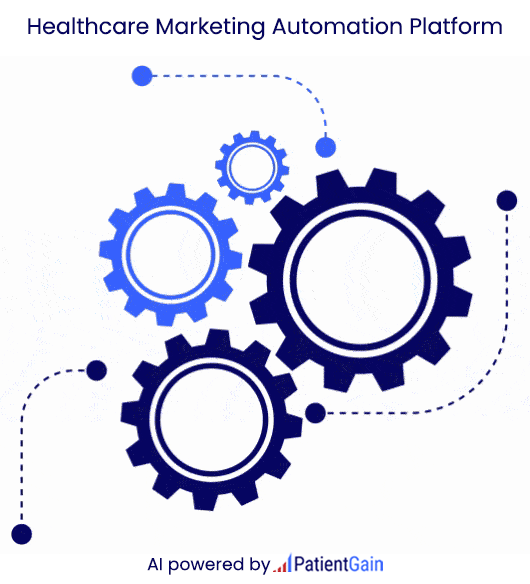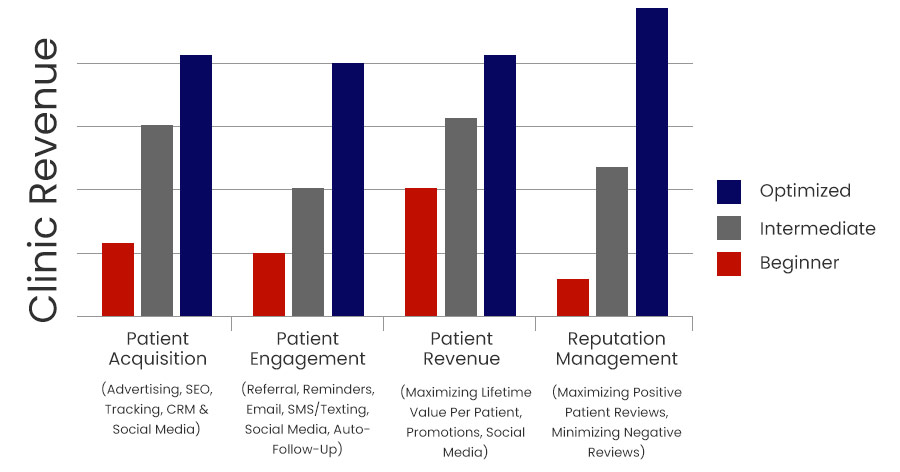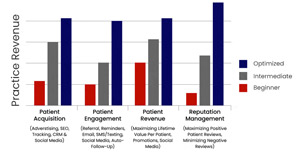AI Medical Marketing For Physicians and Dentists
AI medical marketing harnesses artificial intelligence (AI) tools and technologies to significantly enhance the effectiveness and efficiency of marketing campaigns within the healthcare patient acquisition and patient retention. This approach is transforming how medical practices interact with potential patients and manage their marketing efforts.

Key question asked by providers and practice managers: How AI Can Improve Targeted Healthcare Marketing?
“AI marketing for doctors” refers to utilizing artificial intelligence technology to analyze patient data and tailor marketing campaigns, delivering personalized messages and content to attract new patients and retain existing ones, ultimately optimizing a doctor’s marketing strategy by creating highly relevant and targeted SEO, Google PPC ads, Social media ads, Social media posts (20 posts per month) and outreach (like newsletters based on conditions and treatments & then also offers) based on individual patient needs and preferences.
1. Personalized Patient Experiences
- Tailored Messaging: AI can analyze patient data, such as demographics, preferences, and health conditions, to deliver customized messages that resonate with individual needs.
- Example: Sending personalized reminders for flu shots or follow-up appointments based on a patient’s health history.
- Predictive Analytics: AI predicts future patient needs, enabling proactive outreach with relevant offers, reminders, and educational content.
- Example: Identifying patients likely to need physical therapy and offering targeted campaigns about available treatments.
2. Enhanced Patient Engagement
- AI-Powered Chatbots: AI-driven chatbots provide 24/7 support, answering patient queries, scheduling appointments, and guiding them through the healthcare journey.
- Example: Chatbots offering step-by-step guidance for telehealth appointment setup.
- Social Media Listening: AI monitors social media platforms to gauge patient sentiment, identify concerns, and respond to feedback promptly, building stronger relationships.
- Example: Addressing trending patient concerns about seasonal illnesses via social media campaigns.
3. Improved Campaign Effectiveness
- Predictive Modeling: AI forecasts the success of various marketing strategies, helping healthcare providers allocate resources effectively.
- Example: Predicting which PPC campaigns are most likely to drive traffic for urgent care services.
- Real-Time Optimization: AI-powered tools monitor campaign performance and make instant adjustments to maximize return on investment (ROI).
- Example: Adjusting ad spend in real-time for high-performing geotargeted ads promoting flu clinics.
4. Data-Driven Decision Making
- Comprehensive Data Analysis: AI analyzes large datasets to identify trends, patterns, and insights that inform and refine marketing strategies.
- Example: Analyzing patient engagement data to identify high-priority services for seasonal demand.
- Advanced Market Segmentation: AI segments the target audience into specific groups based on behavior, preferences, and needs, allowing hyper-targeted marketing.
- Example: Creating separate campaigns for young professionals seeking telehealth and seniors needing chronic care support.
5. Technology & Convenience
- Marketing Automation: AI automates repetitive tasks, such as sending personalized email campaigns or posting on social media.
- Example: Automated reminders for annual wellness checkups.
- Predictive Analytics Tools: AI uses historical data to predict trends, helping healthcare providers stay ahead of patient needs.
- Example: Predicting an increase in telehealth demand during flu season and optimizing marketing accordingly.
6. Ethical Considerations and Privacy
- Data Privacy Compliance: As AI collects and processes patient data, healthcare providers must ensure strict adherence to privacy regulations like HIPAA and GDPR.
- Responsible Use: Transparency and ethical practices in AI applications are crucial to maintaining patient trust and fostering long-term relationships.
Key AI Tools for Healthcare Marketing
- CRM Systems: AI-powered CRM tools help manage patient relationships, track interactions, and personalize communications.
- Marketing Automation Platforms: Platforms like HubSpot or Marketo automate marketing efforts, including email campaigns and social media posts.
- AI Analytics Tools: Tools such as Google Analytics with AI enhancements offer in-depth insights into patient behavior and marketing performance.
- Chatbots and Virtual Assistants: AI chatbots streamline patient support and engagement.
Conclusion
By embracing AI and signifiant human oversight, healthcare practices and providers can deliver more effective, personalized, and patient-centric marketing campaigns. AI enables predictive insights, real-time optimization, and deeper audience understanding, leading to improved engagement and better ROI. However, it’s essential to use AI responsibly and ethically to maintain trust, protect patient privacy, and foster meaningful connections. With the right strategies and tools, AI can revolutionize the way healthcare marketing reaches and serves patients. The integration of AI in medical marketing will enable healthcare providers to deliver personalized, efficient, and compliant marketing strategies. By blending AI capabilities with human oversight, medical practices can build trust, improve patient experiences, and achieve sustainable growth.
PatientGain is proven medical and dental marketing automation platform, based on AI agents, apps, HIPAA compliance and professional services. PatientGain healthcare marketing services cost $299/mon to $1999/mon. How AI is reshaping healthcare marketing: Many of these strategies, tools and techniques are included on PatientGain’s PLATINUM monthly service, designed for medical and dental practices.
Overall, AI medical marketing offers potential in how medical practices attract new patients, personalize communications, and refine their marketing efforts. However, it’s essential to use AI responsibly and ethically, integrating it with human oversight to ensure the best outcomes for both patients and practices.


